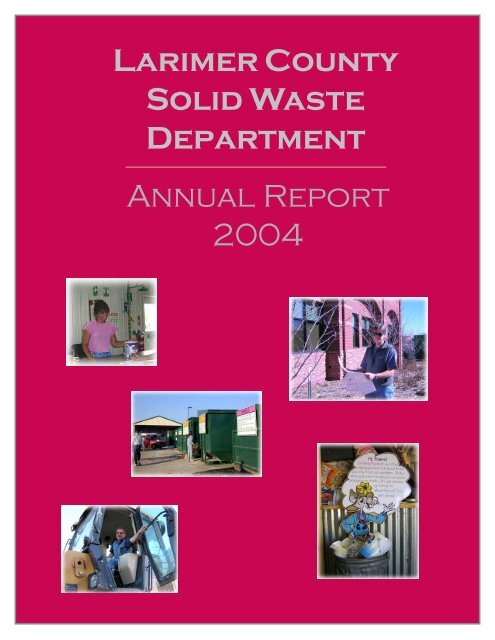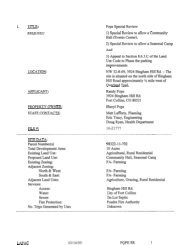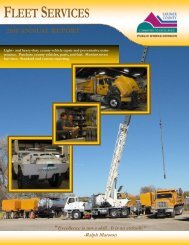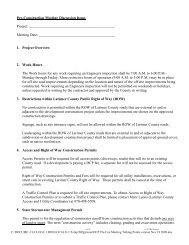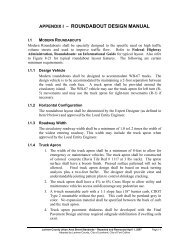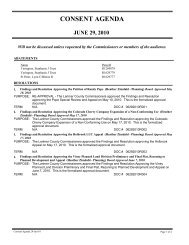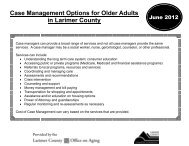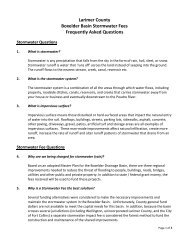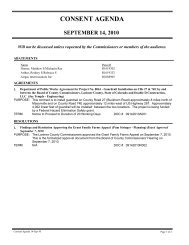Larimer County Solid Waste Department - About Larimer County
Larimer County Solid Waste Department - About Larimer County
Larimer County Solid Waste Department - About Larimer County
You also want an ePaper? Increase the reach of your titles
YUMPU automatically turns print PDFs into web optimized ePapers that Google loves.
<strong>Larimer</strong> <strong>County</strong><br />
<strong>Solid</strong> <strong>Waste</strong><br />
<strong>Department</strong><br />
Annual Report<br />
2004
From From the the Director’s Director’s Chair<br />
Chair<br />
Looking back at 2004 gives us<br />
an opportunity to share what<br />
we have accomplished over the<br />
course of the year, as well as<br />
helps direct us as we plan for<br />
2005.<br />
Early in the year, the Natural Resources<br />
<strong>Department</strong> changed its<br />
name to the <strong>Solid</strong> <strong>Waste</strong> <strong>Department</strong>.<br />
The name change will help<br />
customers better understand<br />
what we do. But changing our<br />
name did not change our mission,<br />
and we remain committed to providing<br />
excellent service.<br />
MISSION<br />
The mission of the <strong>Larimer</strong> <strong>County</strong> <strong>Solid</strong> <strong>Waste</strong><br />
<strong>Department</strong> is to supply integrated waste management<br />
and forestry management in an environmentally<br />
sound manner to the citizens of<br />
<strong>Larimer</strong> <strong>County</strong>. Our primary emphasis is on<br />
quality customer service superior to that normally<br />
found in the public sector.<br />
We are committed to providing excellence in the<br />
services we deliver to the citizens of <strong>Larimer</strong><br />
<strong>County</strong>. We will provide these services in a professional,<br />
simple and cost-effective manner, always<br />
maintaining a high standard of ethics and foresight<br />
and never compromising long-range needs for<br />
short-term benefits.<br />
The <strong>Solid</strong> <strong>Waste</strong> <strong>Department</strong> is<br />
responsible for the <strong>Larimer</strong><br />
<strong>County</strong> Landfill and Recycling<br />
Center, a household hazardous<br />
waste facility, four rural waste<br />
transfer stations and five rural recycling<br />
drop-offs. In addition, the<br />
county forester is part of the department.<br />
In 2004, the landfill received<br />
848,000 cubic yards of trash, an<br />
amount that would fill a 35-story<br />
building with a base the size of a<br />
football field. The recycling center<br />
processed 27,342 tons of recyclables,<br />
and the household hazardous<br />
waste facility diverted<br />
more than 1.8 million pounds of<br />
hazardous and restricted waste<br />
from the landfill. The forester performed<br />
175 site visits and answered<br />
numerous calls on hazardous<br />
vegetation. He also conducted<br />
several building and site<br />
landscape inspections. It was a<br />
busy year<br />
marked with a<br />
few major ac-<br />
complishments<br />
that you’ll<br />
read about in<br />
these pages.<br />
As the <strong>Solid</strong><br />
<strong>Waste</strong> <strong>Department</strong>continues<br />
striving to<br />
provide high<br />
quality services<br />
to <strong>Larimer</strong><br />
<strong>County</strong> residents,<br />
we use<br />
the county’s<br />
vision statement<br />
(at right)<br />
as a tool to<br />
help guide our decision-making<br />
and determine our priorities.<br />
Stephen Gillette<br />
Director<br />
<strong>Larimer</strong> <strong>County</strong><br />
Vision Statement<br />
<strong>Larimer</strong> <strong>County</strong> will:<br />
Build partnerships<br />
Be customer driven<br />
Be good stewards of our<br />
resources<br />
Empower people to take<br />
responsibility<br />
Be a fulfilling and enjoyable<br />
place to work<br />
This annual report is dedicated to<br />
Michelle Duet, landfill gate attendant,<br />
who died early in 2004.<br />
Michelle was an inspiration to our<br />
customers and to our department.<br />
She is missed.
Contents<br />
Landfill ................................................................................................... 1<br />
Recycling Center .................................................................................. 3<br />
Hazardous <strong>Waste</strong>.................................................................................. 5<br />
<strong>Waste</strong> Transfer Stations ...................................................................... 7<br />
Environmental Compliance............................................................... 8<br />
Education................................................................................................ 9<br />
Forestry .................................................................................................10<br />
Looking Ahead ................................................................................... 11<br />
Cover photos, clockwise from top, left: Linda Case, hazardous waste manager, assists a customer;<br />
Dave Lentz, forester, reviews landscape plans; Patty Packrat welcomes visitors to the Garbage<br />
Garage; Jeff Boltz, landfill equipment operator, gets ready to start the day; recyclers make use of the<br />
county’s recycling drop-off.
Landfill<br />
Landfill<br />
In April, the county commissioners<br />
approved a landfill expansion.<br />
Prior to this, the <strong>Larimer</strong><br />
<strong>County</strong> Landfill had about five to<br />
six years of capacity remaining.<br />
The process of obtaining approval<br />
for the expansion took more than<br />
three years. Behind the scenes our<br />
contractor, Terracon, along with<br />
many other people, were busy<br />
working on the technical aspects.<br />
In January, the <strong>Larimer</strong> <strong>County</strong><br />
Planning Commission reviewed<br />
the expansion proposal. This resulted<br />
in a “location and extent”<br />
approval, as well as approval for<br />
a necessary rezoning of a portion<br />
of the landfill. (The zoning had<br />
been changed previously to site a<br />
shooting range on landfill property;<br />
the shooting range has since<br />
been closed and we needed to revert<br />
back to the original zoning<br />
designation.) The final step was a<br />
public hearing with the Board of<br />
<strong>County</strong> Commissioners, at which<br />
the commissioners gave final approval<br />
to the expansion and re-<br />
1<br />
Cubic Yards<br />
1200000<br />
1000000<br />
800000<br />
600000<br />
400000<br />
200000<br />
0<br />
1993<br />
1994<br />
zoning. The expansion will result<br />
in an additional 7 million cubic<br />
yards of air space (volume) at the<br />
landfill, providing<br />
another 15 to 18<br />
years of life based on<br />
current fill rates.<br />
Over the years,<br />
the volume of<br />
trash buried annually<br />
at the landfill<br />
has been mostly increasing.<br />
In 2004,<br />
however, a 10 percent decrease in<br />
volume occurred (see chart below).<br />
The decrease can be attributed<br />
in part to the economy, but<br />
is also due to some trash haulers<br />
choosing to divert waste to other<br />
area landfills. Time will tell if this<br />
trend continues and what other<br />
factors may be contributing to the<br />
decrease.<br />
In January, the landfill experienced<br />
a dramatic rise in the<br />
amount of tires delivered. A scrap<br />
Annual Volumes of Trash at the Landfill<br />
1995<br />
1996<br />
1997<br />
1998<br />
Year<br />
1999<br />
2000<br />
tire handler had been bringing<br />
large quantities of tires requiring<br />
disposal—4,320 tires were<br />
brought to<br />
the landfill<br />
(from this<br />
handler and<br />
other customers)<br />
in<br />
January<br />
alone. This<br />
is much<br />
more than<br />
the monthly<br />
average of 300 to 600 tires. After<br />
a quick investigation, we discovered<br />
that we had the lowest tire<br />
disposal rate in the area. The<br />
<strong>Solid</strong> <strong>Waste</strong> <strong>Department</strong> didn’t<br />
want the landfill to become home<br />
for that many scrap tires, so we<br />
held a public rate hearing in April<br />
at which rates charged for tires<br />
were revised, making the landfill<br />
less attractive for scrap tire dealers.<br />
After the rate change, tire volumes<br />
returned to normal.<br />
2001<br />
2002<br />
2003<br />
2004
A survey of landfill and transfer<br />
station customers asked<br />
their preference for how they<br />
want to be charged for trash:<br />
based on volume or based on vehicle<br />
type. The results showed<br />
that most customers prefer to be<br />
charged per cubic yard. With the<br />
survey results in hand, the <strong>Solid</strong><br />
<strong>Waste</strong> <strong>Department</strong> received approval<br />
from the county commissioners<br />
in a public hearing to<br />
change the methods used for assessing<br />
fees at the landfill and at<br />
the Berthoud and Wellington<br />
transfer stations beginning in<br />
2005. No changes were made at<br />
the Estes Park transfer station,<br />
where disposal fees are already<br />
based on volume. The new fee assessment<br />
method means that customers<br />
will be charged more accurately.<br />
The landfill<br />
partnered<br />
with Killian<br />
Enterprise to<br />
grind about<br />
10,000 tons of<br />
concrete waste.<br />
The result was<br />
a significant<br />
supply of rock<br />
that we will<br />
use on the<br />
landfill roads.<br />
The supply<br />
should last for<br />
many years<br />
and will save us the cost of purchasing<br />
rock for quite awhile.<br />
As we have for the last several<br />
years, the landfill also partnered<br />
with the public and tree haulers,<br />
including other county departments<br />
and the Cities of Fort<br />
Landfill<br />
Landfill<br />
Concrete piles up before being ground into rock, as the pile in the<br />
background has been.<br />
Collins and Loveland, to keep tree<br />
branches separate from regular<br />
trash. The branches, along with<br />
the Christmas trees accepted free<br />
of charge from residents, are<br />
ground into mulch and offered<br />
free to the public in the spring.<br />
Operating a landfill requires more than just<br />
burying trash. <strong>Larimer</strong> <strong>County</strong> and Robert<br />
Nielsen, landfill manager, take pride in managing<br />
the landfill site with the environment and aesthetics<br />
in mind. Phase 3 (see map at left) was<br />
capped and seeded in spring, and with the summer<br />
moisture, we had green fields throughout the<br />
summer and into fall. We also seeded two additional<br />
areas with temporary vegetation (to keep<br />
erosion to a minimum until that land is used<br />
again), and we expect to see more green in these<br />
areas come spring.<br />
In addition, landfill staff widened Fossil Creek,<br />
which runs through the north part of the property.<br />
The widening will slow water flow and decrease<br />
erosion. The area was reseeded as well.<br />
2
Recycling Recycling Center<br />
Center<br />
This was the final year of the<br />
initial 10-year contract for the<br />
operation of the <strong>Larimer</strong> <strong>County</strong><br />
Recycling Center. A public committee<br />
formed late in 2003 continued<br />
working in 2004 to develop a<br />
Request for Proposals (RFP) for a<br />
recycling center operator. The<br />
committee identified<br />
the contractor qualifications<br />
and requirements<br />
necessary to<br />
meet the recycling<br />
needs of our citizens.<br />
The RFP resulted in<br />
five proposals from<br />
vendors interested in<br />
operating the facility.<br />
After evaluation, Recycle<br />
America Alliance,<br />
LLC, (RAA, a wholly<br />
owned subsidiary of <strong>Waste</strong> Management,<br />
Inc.) was unanimously<br />
selected to operate the facility.<br />
RAA’s proposal offered opportu-<br />
3<br />
Prices offered by the<br />
<strong>Larimer</strong> <strong>County</strong><br />
Recycling Center,<br />
December 2004<br />
(Minimum load required is 400 pounds,<br />
except aluminum.)<br />
Material Price/ton Price/lb<br />
Aluminum N/A $.18<br />
Cardboard, baled $24.00 $.012<br />
Cardboard, loose $34.00 $.017<br />
Newspaper $36.00 $.018<br />
Coated paper $44.00 $.022<br />
Office paper $36.00 $.018<br />
Magazines $20.00 $.010<br />
Mixed paper $0.00 $.00<br />
nities to add materials to the curbside<br />
collection of recyclables and<br />
to make the <strong>Larimer</strong> <strong>County</strong> Recycle<br />
Center economically sustainable.<br />
The new contract began January<br />
1, 2005. After a 10-month interim<br />
period, RAA will provide the op-<br />
portunity for collecting more materials<br />
curbside. The City of<br />
Loveland’s <strong>Solid</strong> <strong>Waste</strong> Division<br />
will pilot the program during the<br />
third quarter of 2005. The change<br />
will offer curbside collectors the<br />
choice of collecting materials in a<br />
single stream (in which all allowable<br />
recyclables are mixed in a<br />
single container) or dual-stream,<br />
as they do currently (with paper<br />
in one bin and commingled containers<br />
in another).<br />
The end result of the<br />
new contract and the<br />
offer of single-stream<br />
collection is better customer<br />
service and<br />
greater convenience for<br />
county residents who<br />
recycle. Curbside recyclers<br />
will eventually be<br />
able to add paperboard<br />
and corrugated cardboard<br />
to their recycling<br />
bins at home. The upcoming<br />
changes should translate into<br />
more waste diverted from the<br />
landfill.<br />
Recyclers take advantage of the free drop-off facility at the <strong>Larimer</strong> <strong>County</strong> Recycling Center. The<br />
drop-off accepts office paper, newspapers, magazines and catalogs, junk mail, corrugated<br />
cardboard and brown paper bags, paperboard and low-grade paper, and commingled containers<br />
(glass and plastic bottles and jars; steel and aluminum cans).
Tons Processed<br />
30,000<br />
25,000<br />
20,000<br />
15,000<br />
10,000<br />
5,000<br />
0<br />
Recycling Recycling Center<br />
Center<br />
LARIMER COUNTY RECYCLING CENTER<br />
1993<br />
1994<br />
1995<br />
1996<br />
1997<br />
1998<br />
1999<br />
IN-COUNTY TONS PROCESSED*<br />
1993 1994 1995 1996 1997 1998 1999 2000 2001 2002 2003 2004<br />
JAN 298 1,527 1,540 1,535 1,433 1,652 1,831 2,031 2,190 2,040 2,061 2,161<br />
FEB 385 1,213 1,350 1,537 1,312 1,530 1,688 2,004 1,901 1,857 1,690 1,894<br />
MAR 606 1,591 1,612 1,539 1,498 1,689 2,048 2,384 1,995 1,902 1,862 2,278<br />
APR 1,060 1,514 1,481 1,666 1,583 1,769 1,991 2,204 2,053 2,076 2,077 2,186<br />
MAY 1,042 1,630 1,654 1,712 1,641 1,792 1,917 2,432 2,266 2,206 2,112 2,067<br />
JUN 1,215 1,615 1,652 1,548 1,534 1,849 2,095 2,451 2,049 1,898 2,058 2,316<br />
JUL 1,140 1,468 1,429 1,583 1,853 1,920 1,998 2,275 2,020 2,114 2,276 2,185<br />
AUG 1,288 1,708 1,614 1,556 1,955 2,262 2,065 2,490 2,255 2,135 2,196 2,367<br />
SEP 1,248 1,712 1,509 1,595 1,898 2,325 2,159 2,334 1,835 2,083 2,273 2,227<br />
OCT 1,545 1,717 1,604 1,687 1,843 1,962 1,986 2,508 2,200 2,226 2,281 2,143<br />
NOV 1,521 1,836 1,596 1,558 1,640 1,969 2,205 2,379 2,186 2,095 1,994 2,219<br />
DEC 1,768 1,721 1,519 1,680 1,893 1,993 2,335 2,288 2,008 2,233 2,414 2,381<br />
Total 13,116 19,253 18,561 19,196 20,084 22,713 24,316 27,779 24,958 24,863 25,295 26,424<br />
*As reported by recycling center operator, <strong>Waste</strong> Management, Inc. Includes only recyclable material from sources within<br />
<strong>Larimer</strong> <strong>County</strong>.<br />
2000<br />
2001<br />
2002<br />
2003<br />
2004<br />
4
Hazardous Hazardous <strong>Waste</strong> <strong>Waste</strong> Program<br />
Program<br />
Many changes occurred to<br />
the hazardous waste program<br />
in 2004. Operating hours<br />
were expanded to meet the needs<br />
of our residential customers. The<br />
facility is now open every Saturday<br />
(previously, it had been open<br />
only two Saturdays per month),<br />
and closing time was moved from<br />
3:00 p.m. to 4:00 p.m. With the<br />
added days and hours, a new<br />
technician assistant position was<br />
added to the staff, and the program<br />
diverted more than 1.8 million<br />
pounds of restricted waste<br />
from the landfill.<br />
5<br />
No. of Customer Transactions<br />
Some interesting trends<br />
were noted in the residential<br />
program regarding<br />
the number of participants<br />
as well as the materials<br />
collected and given<br />
away at the Drop ‘n’<br />
Swap. The collection of<br />
regulated waste (waste<br />
banned from landfills) increased<br />
from 2003 by only<br />
3,139 pounds, while the<br />
non-regulated waste (not<br />
officially banned, yet still<br />
unwanted in our landfill)<br />
increased by more than 138,000<br />
pounds. So this year, the household<br />
hazardous waste program<br />
collected more materials like latex<br />
paint than, for instance, pesticides.<br />
Another unusual trend was the<br />
reduction (by about 400) in the<br />
number of residents dropping off<br />
Residential Customers<br />
Year<br />
Hazardous waste technician Jeff Leleszi helps a<br />
customer at the Drop ‘n’ Swap.<br />
waste at our facility. Yet, the<br />
number of shoppers picking up<br />
free reusable items at the Drop ‘n’<br />
Swap increased by more than 850<br />
from the previous year. This year<br />
was the first that we had more<br />
customers taking advantage of<br />
the reuse program as opposed to<br />
the disposal program.
Pounds<br />
2,000,000<br />
1,800,000<br />
1,600,000<br />
1,400,000<br />
1,200,000<br />
1,000,000<br />
800,000<br />
600,000<br />
400,000<br />
200,000<br />
0<br />
1,454 3,476 22,487 72,589<br />
The Estes Park collection<br />
event was the only rural<br />
collection event held in 2004.<br />
The one-day function ran<br />
smoothly, serving 100 residents.<br />
More than 4,000<br />
pounds of hazardous waste<br />
and 10 cubic yards of latex<br />
paint and non-hazardous<br />
waste were dropped off with<br />
us for disposal.<br />
Rural collection events make it<br />
easier for residents in outlying<br />
areas to properly dispose of<br />
leftover household chemicals.<br />
We typically conduct one or<br />
two such events each year.<br />
Hazardous Hazardous <strong>Waste</strong> <strong>Waste</strong> Program<br />
Program<br />
Combined <strong>Waste</strong> Totals Per Year<br />
Hazardous and Non-hazardous <strong>Waste</strong>s<br />
Hazardous and Non-hazardous<br />
75,949<br />
503,994<br />
802,432<br />
1,352,437<br />
1,072,378<br />
1,513,576<br />
1,629,315 1,628,561<br />
1,704,321<br />
1,713,238<br />
1,580,727<br />
1989 1990 1991 1992 1993 1994 1995 1996 1997 1998 1999 2000 2001 2002 2003 2004<br />
Year<br />
1,854,547<br />
Services provided to local businesses increased. The<br />
Business Hazardous <strong>Waste</strong> Assistance Program and<br />
Education (BHAPE) had 237 commercial visits from 166<br />
businesses. Of those, 86 were new customers.<br />
BHAPE works with qualified small businesses to save<br />
them money when managing hazardous and non-hazardous<br />
wastes and to ensure that business wastes are disposed<br />
of or recycled properly. We also offer suggestions<br />
for waste minimization. Types of businesses we work<br />
with include auto repair shops, woodworkers, exterminators,<br />
print shops, photo shops, painting contractors,<br />
and others.<br />
6
<strong>Waste</strong> <strong>Waste</strong> Transfer Transfer Stations<br />
Stations<br />
The <strong>Solid</strong> <strong>Waste</strong> <strong>Department</strong><br />
manages three rural transfer<br />
stations, one each in Wellington,<br />
Berthoud and Red Feather Lakes.<br />
A fourth transfer station in Estes<br />
Park is owned by the department<br />
but operated by <strong>Waste</strong> Management,<br />
Inc. (See bottom of page for<br />
information specific to the Estes<br />
Park Transfer Station.)<br />
Each transfer station<br />
has its own days and<br />
hours of operation,<br />
usually just one or two<br />
days a week, with<br />
fewer hours in the winter.<br />
Transfer stations<br />
make it easier for residents<br />
in these rural areas<br />
to dispose of household<br />
wastes. The<br />
wastes collected are periodically<br />
transported<br />
to the <strong>Larimer</strong> <strong>County</strong><br />
Landfill.<br />
In June 2004, the Red<br />
Feather transfer station<br />
closed when the U.S.<br />
Forest Service, from which the<br />
land was leased, chose not to renew<br />
the lease. We are currently<br />
trying to build a partnership with<br />
another government agency to<br />
bring a transfer station back to<br />
the community. Any new transfer<br />
station will be modernized with a<br />
compactor and electricity. Compactors<br />
are beneficial because<br />
they keep the trash in a covered<br />
container and reduce the likelihood<br />
of wind-blown trash. They<br />
also keep wildlife from getting<br />
into the trash. Berthoud and<br />
Wellington already have compactors<br />
(placed in 2001).<br />
7<br />
No. of Customers<br />
1600<br />
1400<br />
1200<br />
1000<br />
800<br />
600<br />
400<br />
200<br />
0<br />
The transfer stations, funded by<br />
user fees, are not self-supporting<br />
and are subsidized by landfill<br />
user fees when necessary. In<br />
2004, the landfill subsidized the<br />
transfer stations more than<br />
$28,000, or 71 percent of total<br />
expenses.<br />
Customers Served<br />
1459 1453<br />
Wellington Berthoud Red Feather*<br />
Shown above is the number of customers served in 2004 at the transfer<br />
stations. The numbers are similar to those from 2003.<br />
* The Red Feather transfer station closed in June.<br />
The Estes Park Transfer Station,<br />
in operation since<br />
1983, is managed by <strong>Waste</strong><br />
Management, Inc. Estes Park<br />
residents and visitors can take<br />
household trash as well as recyclables<br />
and some hazardous<br />
wastes to the transfer station.<br />
In 2004, the Estes Park Transfer<br />
Station collected and transferred<br />
to the <strong>Larimer</strong> <strong>County</strong><br />
Landfill nearly 60,000 cubic<br />
yards of waste, or 662 tractortrailer<br />
loads.<br />
The <strong>Solid</strong> <strong>Waste</strong> <strong>Department</strong><br />
values customer input and<br />
truly listens to what customers<br />
want. Two customer surveys<br />
were completed in 2004 regarding<br />
the Wellington and Berthoud<br />
transfer stations. The first survey<br />
asked Wellington customers if the<br />
Wellington transfer station should<br />
remain open<br />
Wednesdays during<br />
the summer as it has<br />
been. Their overwhelming<br />
response<br />
was yes, and as a result<br />
we will continue<br />
in 2005 with the<br />
same operating<br />
schedule as in previ-<br />
323<br />
ous years.<br />
The second survey<br />
asked the customers<br />
of both transfer<br />
stations if our fees<br />
should be based on<br />
the volume of trash<br />
contained in a<br />
vehicle or if they<br />
should continue to<br />
be based on vehicle type. The<br />
survey was conducted in<br />
conjunction with a similar one for<br />
landfill customers. Customers of<br />
both transfer stations as well as<br />
the landfill chose to change the<br />
way we charge and start using a<br />
volume-based method. (The Estes<br />
Park transfer station already<br />
charges this way so no change<br />
was necessary there.) The survey<br />
results were brought before a<br />
public hearing in December, and<br />
the county commissioners<br />
approved the change.
The <strong>Solid</strong> <strong>Waste</strong> <strong>Department</strong><br />
strives to minimize the<br />
landfill’s environmental impact<br />
and protect the health and safety<br />
of our customers, employees and<br />
neighbors. We must also control<br />
pollution and comply with state<br />
and federal environmental regulations<br />
to operate as a “sanitary<br />
landfill.” To ensure that our facilities<br />
are in compliance is the job of<br />
the department’s environmental<br />
scientist, Steve Harem.<br />
Gases produced by decomposing<br />
waste are always a concern<br />
at a landfill. With high concentrations<br />
of methane, landfill<br />
gas poses the risk of fire or explosion<br />
and is a source of air pollution<br />
and odors. Gas can migrate<br />
to neighboring properties if not<br />
properly vented at the landfill, so<br />
gas concentrations are monitored<br />
regularly to ensure that methane<br />
does not cross the property line.<br />
In 2004, two new gas monitoring<br />
probes were installed along the<br />
north property boundary. As a<br />
source of air pollution, landfill gas<br />
emissions are regulated by the<br />
Clean Air Act because the gas<br />
contains volatile organic compounds<br />
like benzene and toluene,<br />
which create smog and can cause<br />
health problems. We monitor the<br />
chemistry and volume of gases<br />
produced by the landfill and report<br />
annual emissions to the Colorado<br />
<strong>Department</strong> of Public Health<br />
and Environment (CDPHE) and<br />
the U.S. Environmental Protection<br />
Agency. In 2004, we conducted a<br />
Tier 2 landfill gas evaluation—an<br />
extensive gas sampling and analysis<br />
effort—and concluded that the<br />
landfill’s emissions are well below<br />
regulatory limits. This means that<br />
Environmental Environmental Compliance<br />
Compliance<br />
an expensive gas collection and<br />
control system will not be necessary<br />
for at least another five<br />
years.<br />
Surface water pollution prevention<br />
is another aspect of environmental<br />
compliance. Since sediment<br />
in stormwater runoff can<br />
impact local surface waters, soil<br />
erosion is a major concern at the<br />
landfill. Various operation, construction<br />
and monitoring activities<br />
are conducted to control erosion.<br />
Most significant in 2004 was<br />
the closure of the Phase 3 area<br />
(see map, page 1), with construction<br />
of drainage ditches and pipes<br />
designed to carry runoff water to<br />
the Fossil Creek stream channel.<br />
The entire 14-acre area was<br />
revegetated with grasses to hold<br />
the soil and prevent erosion, especially<br />
on the steep outer slopes.<br />
The county’s engineering department<br />
provided construction management,<br />
on-site inspection and<br />
surveying services for the project.<br />
<strong>Solid</strong> <strong>Waste</strong> personnel periodically<br />
inspect the landfill facility to<br />
identify and correct erosion problems.<br />
Fuel, oil and other liquids<br />
stored and used on site can also<br />
potentially pollute the local surface<br />
waters. To prevent spills of<br />
hazardous materials from storage<br />
tanks or other facilities, we conduct<br />
staff training and regularly<br />
inspect and maintain storage facilities<br />
and equipment. No spills<br />
occurred in 2004.<br />
Groundwater sampling is<br />
conducted quarterly to monitor<br />
the landfill’s impact. Hazardous<br />
chemicals in buried trash may<br />
leach from the landfill and pollute<br />
local groundwater. Our House-<br />
hold Hazardous <strong>Waste</strong> Program<br />
helps prevent groundwater pollution<br />
by keeping hazardous materials<br />
out of the trash. In the areas<br />
south and east of the landfill,<br />
2004 monitoring continued to<br />
show no impact from the landfill.<br />
In the area northeast of the landfill,<br />
where minor contamination<br />
has existed for several years, we<br />
closely monitor the extent and severity<br />
of contamination. Routine<br />
monitoring in 2004 confirmed<br />
that the contamination is not<br />
spreading, and pollutant concentrations<br />
have decreased slightly.<br />
More extensive chemical analyses<br />
conducted in October detected no<br />
new pollutants in the affected<br />
water. The Phase 3 closure should<br />
further improve water quality in<br />
the future. Trash in Phase 3 is<br />
now covered with more than four<br />
feet of soil, including an 18-inch<br />
layer of densely compacted clay,<br />
which will prevent rain and<br />
snowmelt from seeping through<br />
the buried waste and carrying<br />
contaminants into the groundwater.<br />
Environmental Highlights<br />
• Inspections by the Air Pollution<br />
Control Division and the Hazardous<br />
Materials and <strong>Waste</strong><br />
Management Division of the<br />
Colorado <strong>Department</strong> of Public<br />
Health and Environment found<br />
the landfill in compliance with no<br />
violations.<br />
• Closure of the Phase 3 area<br />
was completed in June with the<br />
construction of a final cover and<br />
drainage facilities, and then<br />
revegetation of the area.<br />
8
Education<br />
Education<br />
The goal of the education program<br />
is to provide information<br />
in an accessible manner to<br />
the general public. We are the<br />
only waste facility in northeastern<br />
Colorado that offers tours of<br />
several facilities all on one site:<br />
the recycling center, landfill,<br />
household hazardous waste facility<br />
and education center. Many<br />
tour groups routinely come from<br />
the Denver area, and even as far<br />
away as Nebraska, to visit our facilities.<br />
Visitors are often elementary<br />
students, but range from<br />
preschoolers to senior citizens,<br />
from church groups to scout<br />
groups, and from groups of 120<br />
people to small families.<br />
Because the number of visitors<br />
has increased greatly since the<br />
addition of the education center,<br />
this year staff looked at ways to<br />
keep visitors safe as they walk<br />
among the facilities. Commercial<br />
drivers that come to the landfill<br />
and recycling center don’t expect<br />
to see groups of students walking<br />
around the area. Thus, we have<br />
decided to add crosswalks, signs<br />
and specific waiting areas to ensure<br />
the safety of all involved.<br />
Partnerships are key to the success<br />
of the Garbage Garage education<br />
center, as well. Several<br />
teachers and local groups make<br />
the Garbage Garage a yearly stop.<br />
Without the help of two dedicated<br />
volunteers, Wally Jacobsen<br />
and Wanda Mayberry, tours<br />
would not run as smoothly. We<br />
hope to expand the volunteer<br />
program in 2005, and we are also<br />
hiring part-time help to assist in<br />
giving tours of our facilities.<br />
9<br />
In 2004, about 2,100<br />
people of all ages visited<br />
the education center and/<br />
or our other facilities. The<br />
number of tours scheduled<br />
was 116, and a spring<br />
open house at the<br />
Garbage Garage was a<br />
great success.<br />
The education program continues<br />
to partner with the Cities<br />
of Fort Collins and Loveland in<br />
outreach opportunities. This year,<br />
we put together a comprehensive<br />
advertising package that will include<br />
two television commercials<br />
and four 30-minute talk shows<br />
about specific waste-related topics.<br />
The “Jars and Bottles and<br />
Cans” commercial, with a Wizard<br />
of Oz theme, aired locally on several<br />
cable channels in the fall and<br />
continues to be aired on Fort<br />
Collins’s Channel 27. It can also<br />
be viewed on the <strong>Larimer</strong> <strong>County</strong><br />
and City of Fort Collins Web sites.<br />
The first talk show, an overview<br />
of recycling, was produced in the<br />
fall also. The show is aired periodically<br />
on local cable channels.<br />
The Recyclone Times, a biannual<br />
newsletter distributed in<br />
most major newspapers throughout<br />
the county, is another continuing<br />
example of a successful<br />
partnership among the county<br />
and the Cities of Fort Collins and<br />
Loveland. The newsletter is a hit<br />
with the general public; after distribution,<br />
Cheryl Kolus, the<br />
department’s environmental educator,<br />
typically gets several calls<br />
from individuals and groups requesting<br />
extra copies. Another<br />
newsletter, The Landfill Update, is<br />
also distributed two to three times<br />
a year to a subscriber list of more<br />
than 500.<br />
Information booths at events like<br />
the Holistic Arts Fair in Fort<br />
Collins and at Colorado State<br />
University’s America Recycles<br />
Day celebration help educate the<br />
public about waste and recycling<br />
issues.<br />
T he education program not<br />
only showcases our services,<br />
but also encourages waste reduction<br />
and reuse to decrease the<br />
amount of trash dumped in the<br />
landfill or recycled, since even recycling<br />
consumes resources that<br />
reducing and reusing would not.
In December 2004,<br />
the county forester,<br />
Dave Lentz, was reappointed<br />
as the<br />
<strong>County</strong> Pest Inspector<br />
for another twoyear<br />
period. As such,<br />
Dave addresses four<br />
insect pests or disease<br />
agents in <strong>Larimer</strong><br />
<strong>County</strong>: Dutch elm<br />
disease, spruce ips, mountain pine<br />
beetle and Douglas fir beetle.<br />
This tree shows evidence of a spruce ips<br />
infestation.<br />
Hazardous vegetation<br />
includes branches in<br />
danger of falling on<br />
passersby and trees or<br />
shrubs along roadways<br />
that block the line of<br />
sight for drivers.<br />
Tree recovery was the theme of<br />
2004, with cooler temperatures,<br />
an early monsoon and increased<br />
moisture levels improving<br />
tree conditions. Unfortunately,<br />
the drought conditions of the past<br />
several years have increased the<br />
stress level of trees to the extent of<br />
mortality in some cases. The high<br />
stress levels have caused a rise in<br />
insect populations, both native<br />
and exotic. Improved weather<br />
conditions, however, appear to<br />
have resulted in a collapse in the<br />
more damaging insect populations.<br />
It is now important to identify<br />
the areas of stress and mortality<br />
to take sanitary measures to<br />
reduce roadside hazards and<br />
eliminate brood wood of the more<br />
destructive bark beetles and<br />
bores.<br />
Forestry<br />
Forestry<br />
In 2004, Dave received 161<br />
calls for assistance that required<br />
visits to 175 sites. Hazardous vegetation<br />
complaints increased 76<br />
percent from 2003, with 30 complaints<br />
received, concerning 41<br />
sites needing attention. While a<br />
few of the complaints were addressed<br />
by property owners, 37<br />
were taken care of by the forester,<br />
the county’s road and bridge department<br />
or a hired contractor. In<br />
addition, Dave performed 33<br />
landscape inspections for the<br />
county’s planning and building<br />
services division.<br />
Insect/Disease Pest Inspections Tree Removal Required<br />
Dutch elm disease 4 1<br />
Mountain pine beetle 14 0*<br />
Spruce ips 20 30**<br />
Douglas fir beetle 0 0<br />
*All inspections for mountain pine beetle were owner-requested; although mountain pine beetle was found on a<br />
number of the sites, the forester choose not to take enforcement action.<br />
**This reflects an increase of 400 percent from 2003.<br />
10
Looking Looking Ahead Ahead to to 2005<br />
2005<br />
A year of opportunities awaits the<br />
<strong>Solid</strong> <strong>Waste</strong> <strong>Department</strong> in 2005. The<br />
forestry program may be relocated to<br />
another county department, which will<br />
enable the county to better use this<br />
resource. The landfill will begin charging<br />
its customers based on volume<br />
rather than vehicle type, in response to<br />
customer input; we’ll be researching<br />
possible partnerships to collaborate on<br />
the collection of electronic scrap (such<br />
11<br />
as old computers); and we hope to site<br />
a new transfer station for the Red<br />
Feather Lakes area. In addition, the<br />
new recycling contract will help divert<br />
more materials from the landfill, and<br />
we look forward to setting regular operating<br />
hours for the Garbage Garage<br />
Education Center, so it can be open<br />
for drop-in visitors as well as scheduled<br />
tours. The department will further<br />
explore the possibility of moving its<br />
The <strong>Solid</strong> <strong>Waste</strong> <strong>Department</strong> is...<br />
Building partnerships<br />
Customer driven<br />
A good steward of our resources<br />
Empowering people to take responsibility<br />
A fulfilling and enjoyable place to work<br />
administrative office to the landfill, reducing<br />
travel time and expenses for<br />
employees who do business at both<br />
locations, and of course, we will continue<br />
researching future solid waste<br />
opportunities.<br />
These challenges and opportunities will<br />
keep the <strong>Solid</strong> <strong>Waste</strong> <strong>Department</strong><br />
busy in 2005 and beyond.
<strong>Larimer</strong> <strong>County</strong> <strong>Solid</strong> <strong>Waste</strong> <strong>Department</strong><br />
PO Box 1190<br />
200 W. Oak St., Suite 4000<br />
Fort Collins, CO 80522<br />
(970) 498-5760<br />
www.larimer.org/solidwaste<br />
Printed March 2005 on recycled paper.


